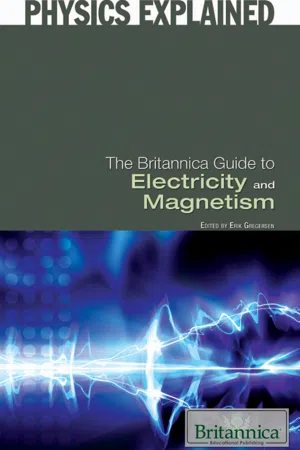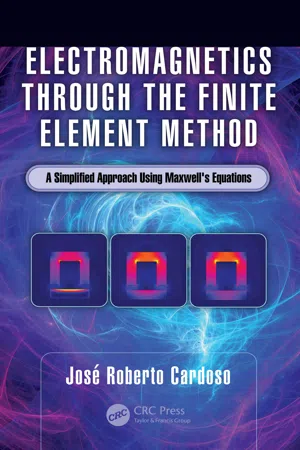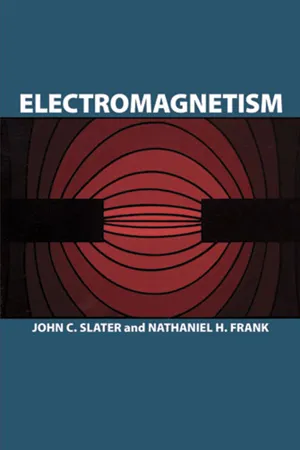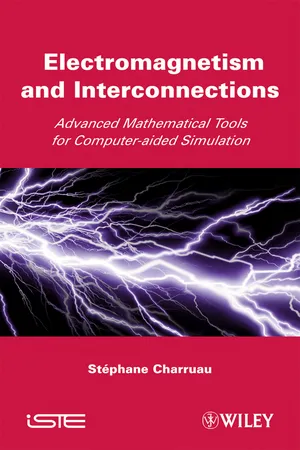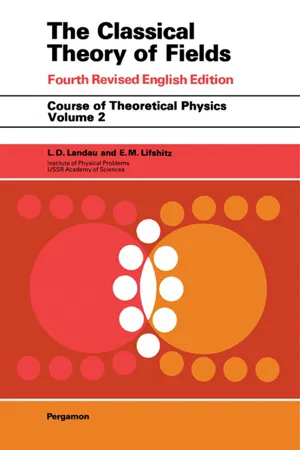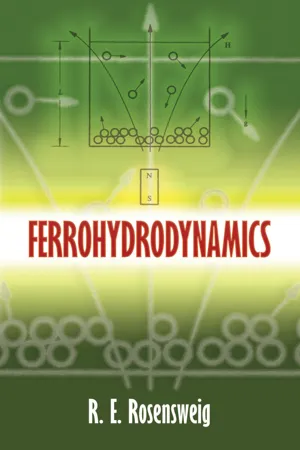Physics
Electromagnetism
Electromagnetism is a branch of physics that deals with the study of the electromagnetic force, which includes both electric and magnetic phenomena. It describes how electrically charged particles interact with each other and with magnetic fields. Electromagnetism is fundamental to understanding the behavior of charged particles, the functioning of electric motors, and the generation of electromagnetic waves.
Written by Perlego with AI-assistance
Related key terms
Related key terms
1 of 4
Related key terms
1 of 3
11 Key excerpts on "Electromagnetism"
- Britannica Educational Publishing, Erik Gregersen(Authors)
- 2010(Publication Date)
- Britannica Educational Publishing(Publisher)
CHAPTER 5 THE FUNDAMENTALS OF ELECTROMAGNETISME lectromagnetism encompasses charge and the forces and fields associated with charge. Electricity and magnetism are two aspects of Electromagnetism.Electricity and magnetism had been known for millennia, but it was not until the 19th century that they were understood to be related. In 1864, James Clerk Maxwell formulated a theory that related the two, and in 1905, Albert Einstein’s special theory of relativity showed that they were two facets of the same phenomenon. Realization of the unity of electricity and magnetism was so long in coming because electric and magnetic forces behave very differently and can be described with different equations. One great difference between the two is that electric forces arise from charges that can be either stationary or moving, but magnetic forces come from and act upon moving charges only.Electric phenomena take place throughout the universe. Even in matter that has no net positive or negative charge, electric effects are present because of the forces between the individual charges. The electric force is much stronger than that of gravity. For two electrons, the repulsive Coulomb force between them is 1042 times stronger than the attractive gravitational force.The regions in which electric and magnetic forces can exert their effects are called electric and magnetic fields. Electric and magnetic forces do not have a distance limit, so the fields can be measured far from the original charges that generate them. A magnetic field can give rise to an electric field, and an electric field can give rise to a magnetic field. A changing magnetic field produces an electric field, as the English physicist Michael Faraday discovered in work that forms the basis of electric power generation. Conversely, a changing electric field produces a magnetic field, as the Scottish physicist James Clerk Maxwell deduced. The mathematical equations formulated by Maxwell incorporated light and wave phenomena into Electromagnetism. He showed that electric and magnetic fields travel together through space as waves of electromagnetic radiation, with the changing fields mutually sustaining each other. Examples of electromagnetic waves traveling through space independent of matter are radio and television waves, microwaves, infrared rays, visible light, ultraviolet light, X-rays, and gamma rays. All of these waves travel at the same speed—namely, the velocity of light (roughly 300,000 kilometres, or 186,000 miles, per second). They differ from each other only in the frequency at which their electric and magnetic fields oscillate.- eBook - ePub
- Peter E. Sutherland(Author)
- 2014(Publication Date)
- Wiley-IEEE Press(Publisher)
1Mathematics Used in Electromagnetism
1.1 Introduction
Electromagnetics is the branch of physical science which deals with electric and magnetic fields and their interactions with each other and with physical objects. We normally think of electricity as the flow of electrons in a conductor, or as static electricity, or lightning. We think of magnetism as in permanent magnets, the earth's magnetism, compass needles, electromagnets, patterns in iron filings, and the like. The physical elements, electrons and charged particles on the one hand, and magnetic materials on the other, are only a portion of the phenomenon. More powerful are the invisible forces which draw objects together or repel them. These forces allow powerful electric machines, motors, and generators, to transform inchoate energy into useful form. They allow the wireless transmission of information, and thus energy, over distances great or small. Although not treated here, information is a form of energy, and thus intimately intertwined with all electromagnetic phenomena. Electromagnetic fields do not exist without physical manifestations, or the physical manifestations without the invisible fields. In order to understand these complex interactions, a special form of advanced mathematics had to be developed. More complex than the calculus used to determine the motion of physical bodies. This mathematics covers diffuse energy distributed over space, and within confined areas. Its first development was with the study of the distribution of heat within a solid, the flow of fluids in pipes, and steam in all its manifestations. When it was discovered that electricity was very similar to a fluid in its behavior, the mathematics was then applied to electrical currents. The distribution of heat inside a solid became the distribution of electric and magnetic fields and variations in current density. - eBook - ePub
Electromagnetics through the Finite Element Method
A Simplified Approach Using Maxwell's Equations
- José Roberto Cardoso(Author)
- 2016(Publication Date)
- CRC Press(Publisher)
2 Fundamentals of Electromagnetism2.1 SOURCES OF ELECTROMAGNETIC FIELD
Richard Feynman was one of the greatest scientists of the twentieth century, who won the Nobel prize in physics and the author of one of the most famous works on fundamental physics (Lectures on Physics ) [16 ]. He suggested in his book that if civilizations became extinct leaving you as the only human being in contact with a new civilization being born and if you could communicate through one sentence during that time, then that sentence should bear the most important information from humanity. This is the concept behind atom formation, where a set of negative electric charges surround a set of positive charges indefinitely. This information, which is considered to be the first mode of interaction in the field of science, marked the beginning of evolution.The concept of electric charge is rooted deep in our knowledge, and only after a closer involvement with science was established, we started to understand its origin through atoms without doubting this concept. We were also able to understand the distribution of isolated electric charges in space thereby understanding several physical phenomenon, such as Coulomb’s law.On the other hand, the human body, at a microscopic level, essentially consists of electric charges. Feynman also asserted that if an unbalance of only 10% is found between positive and negative electric charges in our body, the intensity of force between you and the next person, would be sufficient to move the entire Earth!These electric charges are responsible for the generation of electromagnetic fields. Their state of animation is also relevant; if electric charges are stationary or moving (constituting an electric current), their actions over electromagnetic fields are completely different, as we are going to discuss next. Actions of electric charges in applied Electromagnetism are based on the macroscopic conception of the phenomenon. - eBook - ePub
- John C. Slater, Nathaniel H. Frank(Authors)
- 2012(Publication Date)
- Dover Publications(Publisher)
The study of forces, on the other hand, is difficult and complex. The first forces brought into mathematical formulation were gravitational forces, as seen in planetary motion. Next were elastic forces. Then followed electric and magnetic forces, which are the subject of this volume. Their study was mostly a product of the nineteenth century. During the present century, it has become clear that electromagnetic forces are of far wider application than was first supposed. It has become evident that, instead of being active only in electrostatic and magnetostatic experiments, and in electromagnetic applications such as the telegraph, dynamo, and radio, the forces between the nuclei and electrons of single atoms, the chemical forces between atoms and molecules, the forces of cohesion and elasticity holding solids together, are all of an electric nature. We might be tempted to generalize and suppose that all forces are electromagnetic, but this appears to be carrying things too far. The prevailing evidence at present indicates that the intranuclear forces, holding together the various fundamental particles of which the nucleus is composed, are not of electromagnetic origin. These forces, of enormous magnitude, and appearing in the phenomena of radioactivity and of nuclear fission, appear subject to laws somewhat analogous to the electromagnetic laws, but fundamentally different. In spite of this, the range of phenomena governed by electromagnetic theory is very wide, and it carries us rather far into the structure of matter, of electrons and nuclei and atoms and molecules, if we wish to understand it completely. The equations underlying the theory, Maxwell’s equations, are relatively simple, but not nearly so simple as Newton’s laws of motion. Instead of stating the whole fundamental formulation of the subject in the first chapter, as one can when dealing with mechanics, about half of the present book is taken up with a complete formulation of Maxwell’s equations. We start with simple types of force, electrostatic and magnetostatic, and gradually work up to problems of electromagnetic induction and related subjects, all of which are formulated in Maxwell’s equations.In the development of electromagnetic theory, there has been a continual and significant trend, which in a way has set the pattern for the development of all of theoretical physics. This has been the trend away from the concept known as “action at a distance” toward the concept of field theory. The classical example of action at a distance is gravitation, in which simple nonrelativistic theory states that any two particles in the universe exert a gravitational force on each other, acting along the line joining them, proportional to the product of their masses, and inversely proportional to the square of the distance between them. Such a force, depending only on the positions of the particles, quite independent of any intervening objects, is simple to think about, and formed the basis of most of physical thought from the time of Newton, in the latter half of the seventeenth century, on well into the nineteenth century. The first electric and magnetic laws to be discovered fitted in well with the pattern. First among these was Coulomb’s law. Coulomb investigated the forces between electrically charged objects, and found that the force between two such objects was in the line joining them, proportional to the product of their charges (which could be defined by an experiment based on this observation), and inversely proportional to the square of the distance between them, in striking analogy to the law of gravitation. Magnets similarly fell in with the scheme. A theory of the forces between permanent magnets can be built up by considering that they contain magnetic north and south poles, and that the force between two poles is proportional to the product of the pole strengths, and inversely proportional to the square of the distance. It is true that single poles do not seem to exist in nature, but an ordinary magnet can be considered as made up of equal north and south poles in juxtaposition, a combination known as a “dipole.” - eBook - ePub
Human Exposure to Electromagnetic Fields
From Extremely Low Frequency (ELF) to Radiofrequency
- Patrick Staebler(Author)
- 2017(Publication Date)
- Wiley-ISTE(Publisher)
1 Concepts of Electromagnetic FieldsElectromagnetic fields are produced from natural and artificial sources. We distinguish between electric, magnetic and electromagnetic fields. Whether static or variable in time, they each have physical properties that produce specific interactions with biological organisms: plant, animal and human.To provide a better understanding of the interaction mechanisms, the concepts of Electromagnetism and the associated terminology are presented in this chapter [FEY 15].1.1. Concepts of fields
1.1.1. Introduction
In physics, a field can be defined as an area of influence. We are immersed in the Earth’s gravitational field (the area within which the Earth attracts objects) and in electromagnetic fields (areas within which we can pick up television broadcasts and mobile phone signals, for example).Gravity acts between two bodies that have a mass, while an electric field acts on positive or negative electric charges (electric charge is a fundamental property of matter, along with mass). These interactions are due to forces whose intensity is proportional to the mass of the objects or to the value of the electric charges. They decrease with the square of the distance that separates them and cancel each other out ad infinitum. The expression of these forces is identical. Their intensity in Newton (N) is given, respectively, by the law of gravitation and by Coulomb’s law (in classical physics):- – law of gravitation between two masses m1 and m2 :
[1.1a ]- – Coulomb’s law between two electric charges q1 and q2 :
[1.1b ]where d is the distance in meters between the two objects, G is the universal gravitational constant, and:Coulomb’s constant (N·m2 ·C–2 ), and “c” is the speed of light (≈ 3 × 10+8 m·s–1 ). εois a constant that will be introduced later on. If we refer to the Earth, FG1/2represents the weight and [1.1a] becomes simply P = m·g with g = 9.81 m·s–2 - eBook - ePub
Electromagnetism and Interconnections
Advanced Mathematical Tools for Computer-aided Simulation
- Stephane Charruau(Author)
- 2013(Publication Date)
- Wiley-ISTE(Publisher)
Chapter 1Theoretical Foundations of Electromagnetism
This first chapter is devoted to a brief overview of Electromagnetism needed for modeling the electrical behavior of interconnections traveled by very high speed digital or pulsed signals. After a quick look at the historical development of Electromagnetism, the tremendous interest in the theory of distributions applied to Electromagnetism is highlighted in terms of digital signal transmission analysis. Then, the strictly useful elements of this theory and the necessary vector analysis are discussed, thus allowing an original derivation of Maxwell’s equations from the intuitive geometric properties of the linear relations between electromagnetic features which are modeled by polar and axial vector distributions. The integral forms of Maxwell’s equations are presented.1.1. Elements of the theory of distributions applied to Electromagnetism
1.1.1. Choosing a presentation of the foundations of Electromagnetism
Electromagnetism phenomena [ROC] [JAC1], the foundations of transmission lines analysis, concern the interactions between electricity and magnetism in nature observed experimentally by Oersted in 1819 (magnetic field created by an electrical current) and by Faraday in 1830 (electrical current created by a variable magnetic field), completed by the propagation of electromagnetic waves discovered by Hertz in 1887. The results of Oersted’s experiments were translated into mathematical laws by Biot and Savart in 1820 and then by Ampere, and those of Faraday by Lenz and then by Foucault in 1850, thus leading to Maxwell’s theory of 1873, the equations of which got their final form thanks to Heaviside in 1884. - eBook - ePub
- Jerry Marion(Author)
- 2012(Publication Date)
- Academic Press(Publisher)
CHAPTER 4The Electromagnetic Field Equations
Publisher Summary
This chapter discusses the field quantities that may depend upon time. Under such conditions, there is an interdependence of the field quantities and it is no longer possible to discuss the electric and magnetic fields separately. Maxwell’s equations are the mathematical abstractions of experimental results, but it is found that the description of an extremely wide range of phenomena can be made by means of Maxwell’s equations without contradiction. Thus, they appear to be a true representation of the classical electromagnetic field. The chapter presents the formulation of the field equations to show that their solutions are unique, to discuss the scalar and vector potentials of the field, and to consider what is meant by the energy density of the field. The wave character of the electromagnetic field, the radiation sources, and the interaction of electromagnetic radiation with various types of matter are illustrated in the chapter.4.1 Introduction
In the preceding chapters we have discussed the mathematical description of static electric and magnetic fields. The basic equations which relate to such fields were summarized in Section 1.9 . We now wish to consider the more general situation in which the field quantities may depend upon the time. Under such conditions there is an interdependence of the field quantities and it is no longer possible to discuss separately the electric and magnetic fields—we are forced to consider the generalized concept of an electromagnetic field . It was James Clerk Maxwell, using the results of Michael Faraday’s researches, who succeeded in constructing a unified theory of electromagnetic phenomena* and in his honor the general, time-dependent electromagnetic field equations are called Maxwell’s equations - eBook - ePub
Liquid Crystal Displays
Fundamental Physics and Technology
- Robert H. Chen(Author)
- 2011(Publication Date)
- Wiley(Publisher)
field . This then was the basic idea of a field to intuitively conceptualize Electromagnetism.Figure 2.3 Faraday’s own drawing of the magnetic lines of flux.The idea of lines of force constituting a field to describe the electric and magnetic effects was not the only pivotal concept invented by Faraday; another critical idea was that the field lines could be superimposed to describe the cumulative effect from many different sources of electric and magnetic force. This principle of superposition can reduce a very complicated collection of electromagnetic sources of force into a simple addition of the different contributions from the various sources. That is, at a given point in space, no matter what the distribution of the other electric or magnetic charges happens to be, each contribution to the field at that point can be simply added to derive their total cumulative effect. No matter how the electric or magnetic field was produced, whatever its character, or what the distribution of sources is, the cumulative field by itself only, will determine the influence on anything at the point in space in question. As a consequence, field theory can resolve a physically very complicated electromagnetic situation into something amenable to a simple additive analysis.Maxwell’s EquationsPhysics is based on observed phenomena, and any theory must of course comport with what is observed in Nature. The intricate interplay between electric and magnetic phenomena was unambiguously observed—a moving charge feels the magnetic force and a moving charge can generate a magnetic force but not in the same direction. That is, one moves, the other is created but not directly in-line; one dies, the other then expires; one again stirs, the other is reborn, but again not in-line; the problem was how to describe that in a coherent and self-consistent mathematical theory. - eBook - ePub
Energy Medicine - E-Book
The Scientific Basis
- James L. Oschman(Author)
- 2015(Publication Date)
- Churchill Livingstone(Publisher)
Much of the discussion that follows will concern the behaviour of electrons and other charged particles. We shall see that when a charge moves, magnetic fields are produced. And we will also see that the opposite is true: Magnetic fields alter the motions of nearby charges. These principles are profoundly important for energy medicine. Many of the techniques used in energy medicine look like New-Age hocus-pocus until they are viewed through the discerning eyes of the physicist and biophysicist. Hence this chapter is an introduction to the worldview from these perspectives.It is necessary to look at the nature of these particles in some detail because many of the seemingly remarkable phenomena in energy medicine will remain inexplicable without reference to the behaviour of these fundamental particles. What is being presented in this section goes deep – to the fundamental properties of all matter in the universe. Readers may wish to postpone reading this section until their curiosity has built up from the concepts presented in later sections of the book, and they feel motivated to dig deeper.Understanding the basic physics and quantum aspects of charged particles is a continuing challenge for scientists from every field of inquiry. Many of the fundamental questions have not been answered completely. Other questions have several answers, with great minds disagreeing about which is correct. This must not stop us from looking at the pieces of the puzzle we understand or think we understand. As we look at these concepts, we must keep in mind that all of the information is subject to change as more discoveries are made. Some of the more extraordinary conclusions that have been reached are not agreed upon by all physicists. For example, there is abundant evidence for non-locality, i.e., at a fundamental level, all of the particles in the universe are dependent on and continuously interacting with all of the other particles in the universe. All parts are continuously in relationship and communication. Some physicists and quantum physicists regard this concept as preposterous; others observe phenomena every day in their laboratories that can only be explained in this way. - eBook - ePub
- L D Landau(Author)
- 2013(Publication Date)
- Pergamon(Publisher)
CHAPTER 3 CHARGES IN ELECTROMAGNETIC FIELDS Publisher Summary This chapter explores charge particles in electromagnetic fields. In the theory of relativity, elementary particles are considered as rigid bodies whose dimensions all remain unchanged in the reference system in which they are at rest. However, it is easy to see that the theory of relativity makes the existence of rigid bodies impossible in general. A charge located in a field not only is subjected to a force exerted by the field, but also in turn acts on the field, changing it. However, if the charge e is not large, the action of the charge on the field can be neglected. The equations of motion of a charge in an electromagnetic field are invariant with respect to a change in sign of the time, that is, the two time directions are equivalent. Thus, if a certain motion is possible according to the equations of mechanics, the reverse motion is also possible, in which the system passes through the same states in reverse order. Furthermore, the gauge invariance of the equations of electrodynamics and the conservation of charge are closely related to one another. The constancy of the acceleration of a charged particle is related to the fact that the electric field does not change for Lorentz transformations having velocities V along the direction of the field. § 15 Elementary particles in the theory of relativity The interaction of particles can be described with the help of the concept of a field of force. Namely, instead of saying that one particle acts on another, we may say that the particle creates a field around itself; a certain force then acts on every other particle located in this field. In classical mechanics, the field is merely a mode of description of the physical phenomenon—the interaction of particles. In the theory of relativity, because of the finite velocity of propagation of interactions, the situation is changed fundamentally - eBook - ePub
- R. E. Rosensweig(Author)
- 2013(Publication Date)
- Dover Publications(Publisher)
3Electromagnetism AND FIELDSWhich is more real, fields or matter? This question often arises, but it is clear that the two views complement and reinforce each other. The discussion so far has emphasized the material point of view. In this chapter the field description is used, and partial differential equations are obtained governing the distribution of magnetic field in space. The field description then becomes the basis for deriving an expression for the state of stress in vacuum, the remarkable Maxwell stress tensor. Subsequently, with this understanding it will be possible to advance in Chapter 4 to the analysis of stress in magnetized media. For that purpose the complete Maxwell’s equations of the electromagnetic field will be needed, as well as certain expressions for energy density that are derivable from them. This treatment begins with another look at Coulomb’s law.3.1 Magnetostatic field equationsCoulomb’s law of magnetism was introduced as equation (1.1) . The H field generated at position r by a point pole p located at the origin of coordinates can be writtenFigure 3.1 represents the field piercing a surface s of arbitrary shape surrounding the pole.3.1 An imaginary closed surface S that encloses a point pole at the origin. This diagram is used with Coulomb’s law to derive the equation ∇.B = 0.Because H can be regarded as the density of field lines, the flux of field lines through a surface patch of area dS is given bywhere dΩ = r·dS/r3 is the solid angle in steradians subtended by dS . Note that only the solid angle appears in the rightmost term, and not the radius, so the enclosing surface may be of any shape. The flux of field out of a closed surface is thenbecause the solid angle subtended by a whole sphere is 4π steradians. For N poles inside S, where the ith pole contributes an amount Hi
Index pages curate the most relevant extracts from our library of academic textbooks. They’ve been created using an in-house natural language model (NLM), each adding context and meaning to key research topics.
Explore more topic indexes
Explore more topic indexes
1 of 6
Explore more topic indexes
1 of 4
